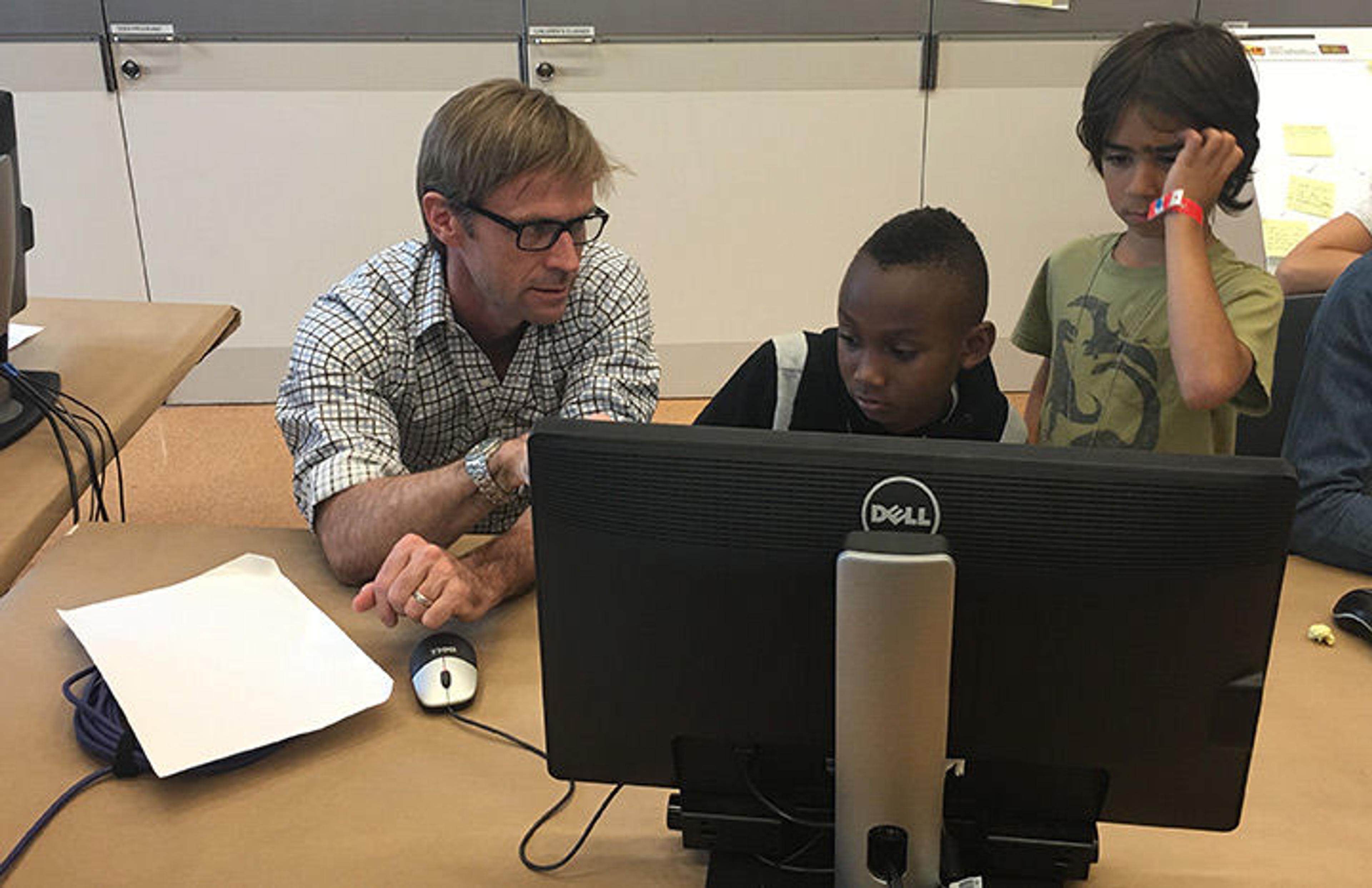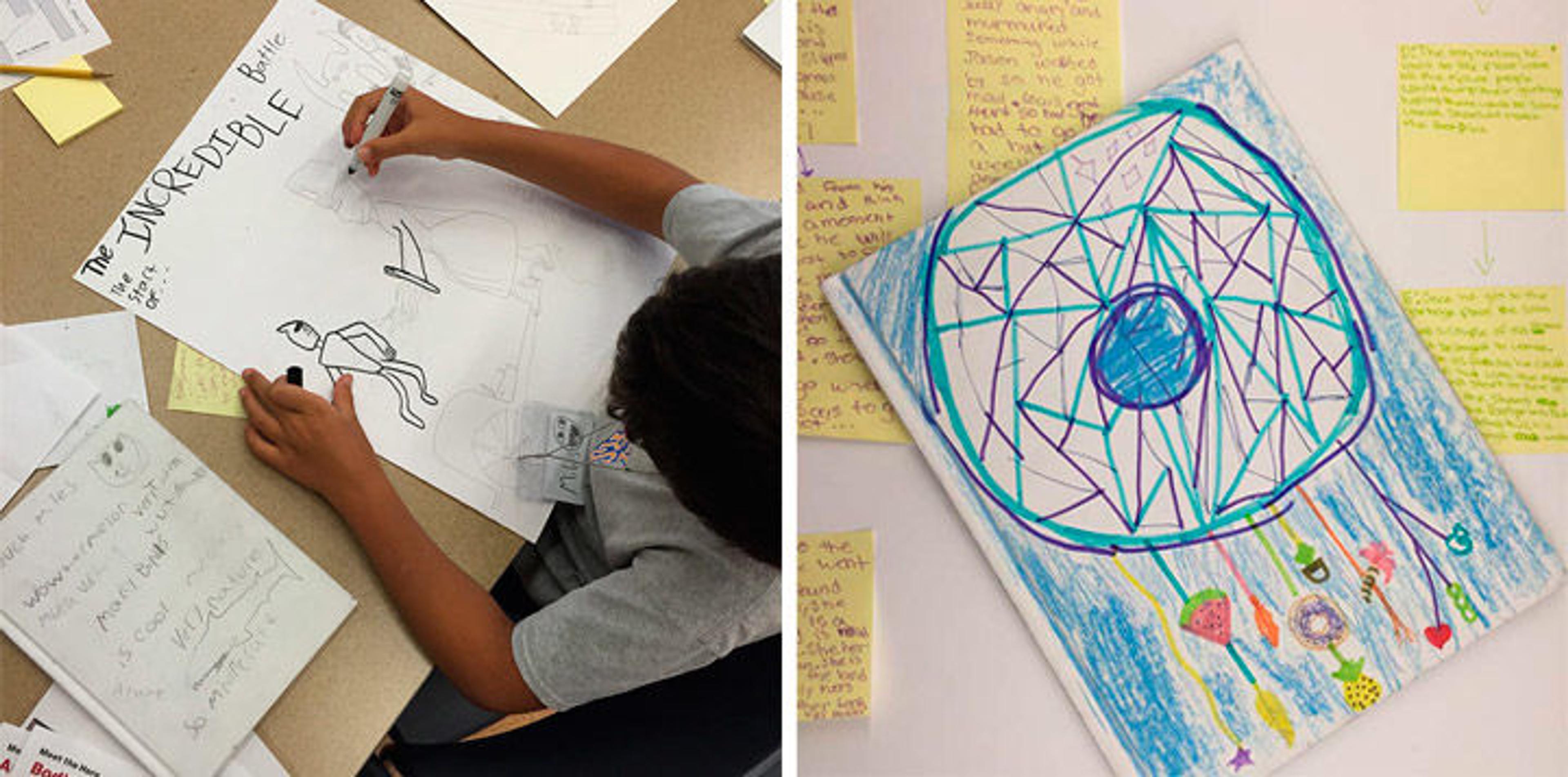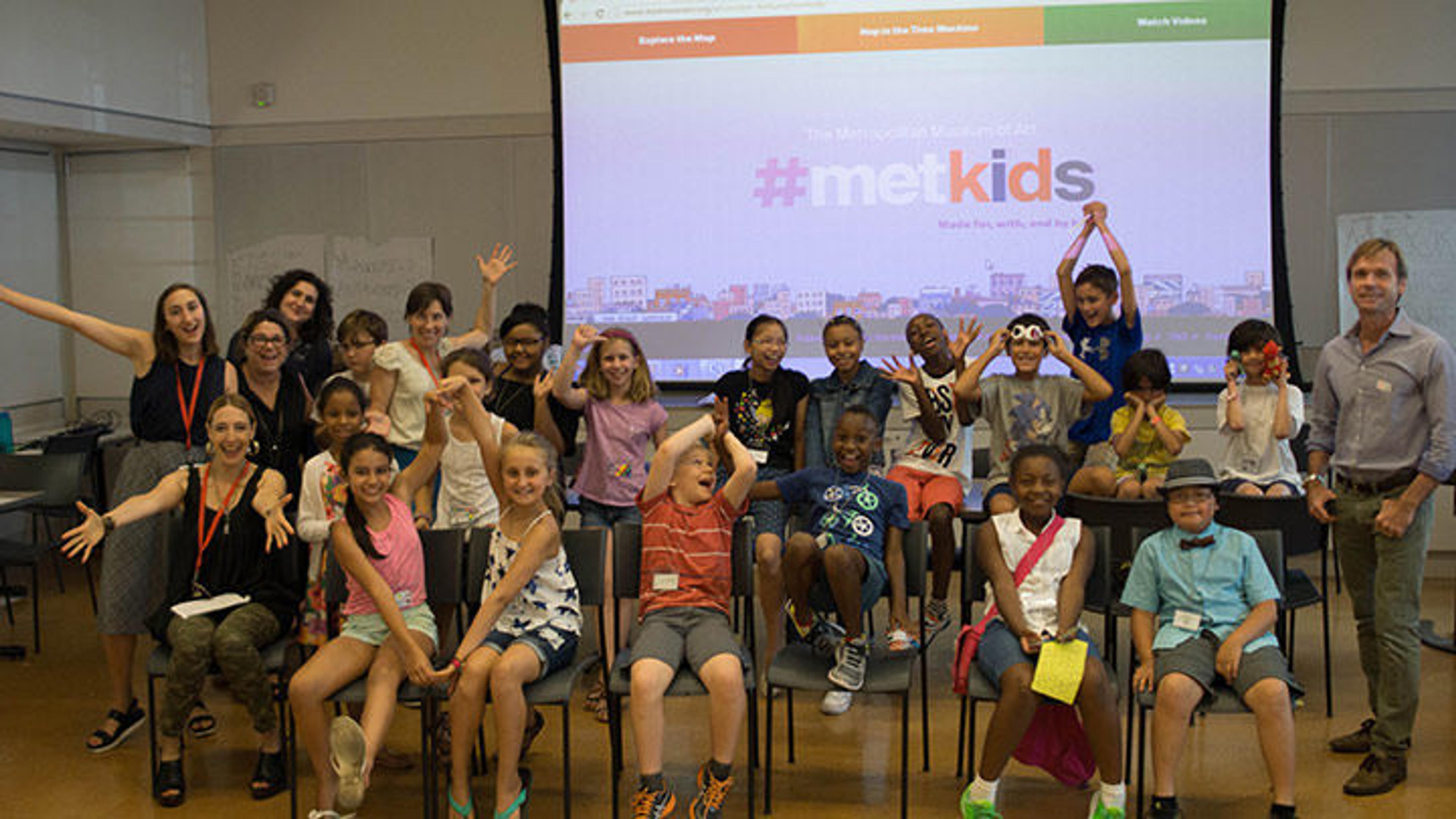
Author Bill Doyle and a few kid writers at the #MetKids Digital Storytelling Lab. Photo by Masha Turchinsky
As you may have seen for yourself, The Met is a big place. There's so much to see and experience! With two million square feet and four city blocks of art to cover when you visit, you may find yourself asking: Who are the people depicted in the paintings and sculptures? What's happening in that photograph? Where does the action take place? How did this art even get here? So, it may not surprise you that this Museum is a great place to hear stories about art from around the world.
Now imagine that you not only get to hear these stories, but also are invited to make your own tale inspired by what you saw and your imagination. That's just what happened during our first #MetKids Digital Storytelling Lab, which attracted writers ages 8 to 12 from around New York City. For one week in July, the Museum became a #MetKids writers colony, with young authors making their own stories with alternate endings inspired by the art they explored. Working in small teams, they selected heroes, villains, and themes for their stories and got busy with their plots. We got a lot done in that week.
Bill Doyle, who is what you might call a storytelling professional, led the Lab. Bill is the author of over 30 books for children, with more than two million copies in print with publishers such as Scholastic Corporation; Random House; Little, Brown and Company; and Chronicle Books. For one week, he and a team of intrepid #MetKids worked together to learn about the craft of storytelling and then created original stories inspired by art in The Met's galleries.
I had the chance to speak with Bill in order to find out more about his path as a writer and why creating stories with multiple endings is a great option at The Met. Of course, we also wanted to gather some of his insider writing tips and pass them on to all of you so that you can start writing your own stories.

A girl takes notes for her story in The Met's galleries. Photo by Skyla Choi
Masha Turchinsky: When and how did you start writing? What inspired you to become a children's book author?
Bill Doyle: While I've wanted to write since I was a kid, I didn't always know I wanted to write for kids. At eight, I was really into clacking out spooky stories on my plastic toy typewriter. But what really got me excited about writing was when my grade school teacher, Mrs. Fenster, let me stage a mystery I wrote. Seeing the kids in my class watch my play and "ooh and ahh" at the nutty plot twists and the big revelation of whodunit was incredible. It was something I'll never forget and something I wanted to experience more.
Years later, I went to [New York University Tisch School of the Arts] for graduate dramatic writing and thought I'd be creating stories for grown-ups. That all changed when I got hired by Sesame Street. I was hooked on writing for kids within a week. And that's where I learned something very important: never talk down to kids.
Masha Turchinsky: What interests you most about stories where readers can make choices for the main character?
Bill Doyle: An essential part of being an author is making decisions . . . so normally writers have all that narrative control or storytelling superpower to themselves. What's amazing about having different paths for the characters to take is that it gives readers some of the writer's superpower. The readers get to decide where the story will go. Plus, because there are multiple endings, the writer gets to play out different scenarios—a rare treat!
Masha Turchinsky: Is writer's block real? If so, how do you cope and get back on track?
Bill Doyle: Maybe I live in a world of denial, but because I'm usually under one deadline or another, I don't have time for writer's block. Fear of not finishing on time is a great motivator and I just force myself to keep typing. Even if I find myself heading down a weak narrative thread, sooner than later that thread will strengthen in ways I hadn't even imagined. I always tell kids the key to getting past "writer's block" is to keep your rear end in the chair and write, write, write.

Left: A boy illustrates his book cover during the #MetKids Digital Storytelling Lab. Right: A finished book. Photos by Skyla Choi
Masha Turchinsky: What are the most important ideas to keep in mind when creating a new story? Any tips for #MetKids who are just starting out as writers?
Bill Doyle: Over the years, I've learned there should be clear, sizable stakes in kids' stories. Someone should be in danger of losing something important to them. And there should be a bit of edge. Let's face it, we've all been worried about losing something. And other kids stories that have stood the test of time are always a little scary: check out the old school fairy-tales. Even when I write stories that are comedies, the stakes are high: for example, if our hero family doesn't win the contest, the wicked bigwig in town will make everyone's lives miserable. You get the idea.
Bill Doyle: In this most recent storytelling lab, I really wanted kids to learn the importance of the Major Dramatic Question, or MDQ. It's something I learned from Milan Stitt, who wrote the play The Runner Stumbles. A story needs a powerful MDQ if it wants to succeed. You know, like: "Will Harry defeat Voldemort?" or "Will Hamlet avenge his father?," or "Will the alien eat everyone?" It's a high-level concept and I was impressed with how quickly and easily the kids in the Lab grasped it.
Masha Turchinsky: What's unique about teaching storytelling at The Met?
Bill Doyle: I keep little objects on my desk as inspiration for my writing. When you look for inspiration in The Met, you take that idea and magnify it by the billionth degree. Everywhere you turn in The Met, there are stories shouting to be told. From the art itself and the grand gallery spaces to the conversations being had by visitors from all over the planet to the volunteers and staff who are always on hand to answer any questions.
Masha Turchinsky: You and the group used Twine to build your stories. Why? Are there any benefits?
Bill Doyle: Twine is like some kind of digital miracle. When I wrote the book Worst Case Scenario Ultimate Adventure: Everest, it took me a couple weeks to create a flow chart that had all the 26 possible endings and the 50 or so possible decisions. Today, you could make that same flowchart in a half day or less. There's really no learning curve. The Lab kids sat down and immediately knew what to do. And better yet it's a free resource with tool and capabilities that are constantly growing.
Masha Turchinsky: Any final words of advice for emerging #MetKids authors?
Bill Doyle: Get a writer's notebook. Keep filling it up with amazing ideas . . . and then fill it up with 10 more. Keep visiting the galleries at The Met to discover the seeds of your next great narrative. Keep searching for MDQ's in all your favorite stories and invent your own. Keep writing and wowing readers with your stories . . . just as #MetKids authors wowed me and the rest of the team at The Met's Storytelling Lab!

The latest #MetKids authors. Photo by Skyla Choi
You can find out more about Bill Doyle and his latest book The Prizewinners of Piedmont Place on his personal website.
Do you have a story inspired by The Met collection that you want to write? Tell us about it.